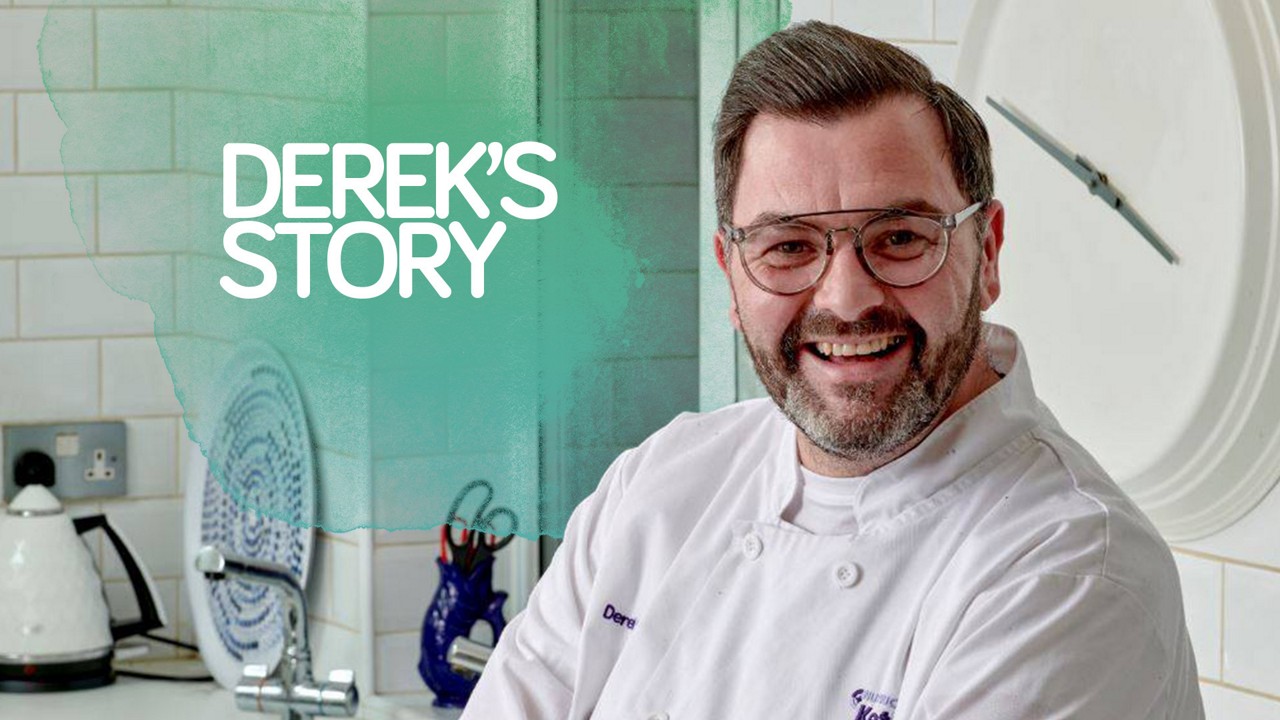
#EpilepsyandMe - Derek's Story
Derek Clarke is a Nutricia team chef who also works with Matthew’s Friends and The Daisy Garland charities. His career started when he qualified as a Master Baker with Rank Hovis in 1992, and since then he has worked for a top London hotel, opened a cake shop in Chester and made countless wedding cakes. Today, his work for Nutricia involves developing new recipes for ketogenic and metabolic diets, as well as hosting cookery workshops for families.
Ten years ago, my godson Tylan was born with a metabolic disorder called Phenylketonuria (PKU), which means he can’t eat any protein in his diet. I had a cake shop in Chester at the time, so I started coming up with recipes and making food that he would be able to eat.
As it turns out, a metabolic representative who worked for Nutricia and who lived in Chester got wind of what I was doing, paid me a visit and asked if I’d be interested in making some cakes for a PKU event she was organising - two patients with PKU were getting married and she asked me to make their wedding cake. After that I started doing some cooking demos with Nutricia and the role just spiralled from there, until about six years ago I started looking at the ketogenic diet as well as the metabolic diet.
Getting to grips with the ketogenic diet
My introduction to the ketogenic diet was through a meeting Nutricia arranged with Emma Williams, the CEO of the ketogenic diet charity Matthew’s Friends. Emma’s son Matthew was one of the first people to go on the diet twenty years ago, when he was seven years old, and in 2004 she started Matthew’s Friends to help other parents who are going through the same situation. I listened to Matthew and Emma’s story, hearing how hard it had been for them to cope with his epilepsy before the ketogenic diet changed their lives. It was truly inspirational.
I thought that if I could design even one recipe that might help parents in the kitchen with the ketogenic diet, that would be great - and as soon as I started I began to get a feel for it. I did some medical training with Nutricia to get an understanding of what complex epilepsy is and how food can affect the quantity of seizures, either by reducing them or stopping them completely. I was learning about fat content and ketones and all these other aspects of the diet, and then from my point of view I was looking at how to create a recipe - whether for a cupcake or a spaghetti bolognese - that will provide them with that correct quantity of fat to keep them in ketosis and reduce their number of seizures. So I have to look at the medical side, but then also think about creating something easy and simple for parents in the kitchen that will help the patient in the long run.
Experimenting with ingredients
The ketogenic diet is built around having no carbohydrates (or extremely low carbohydrate content), extremely low protein and high fat content. So, as a chef, it’s a case of choosing ingredients that adhere to those criteria. Different patients are also on different ratios of fat to carbs/protein; some are on four to one, three to one and two to one, which can make certain recipes more difficult than others.
My background is as a baker, so flour is a huge part of that - but obviously we can’t use flour in the ketogenic diet. Fortunately, there are a lot of substitutes like fibre flour, ground almonds and coconut flour - it’s just a case of trying to blend the ingredients in the right way for the best outcome. When you’re making a cupcake, for example, you want it to taste and look exactly like a normal cupcake, so certain recipes are trickier than others and there can be some experimentation involved!
When a new ingredient or product comes along it can open up a lot more possibilities with the recipes. For example, once fat powders became available, there was no longer a need to use large quantities of oil to increase fat content, and it became possible to make food that was a lot less greasy. Fibre flour has been brilliant for making low carb bread, and we can’t use sugar so a lot of my recipes involve sweeteners. At the same time, berries are a great go-to natural sweetener - it’s always handy to have raspberries and blueberries in the fridge because they’re a good start to any recipe.
Seeing the progress
Since starting to develop recipes for the ketogenic diet, I’ve done work with Matthew’s Friends and The Daisy Garland charity to help support parents of children with epilepsy. Both charities sponsor healthcare professionals to create more dietitians in the community and do research that provides insights for parents and patients. They hold events throughout the year which bring parents, caregivers and patients together so they can meet others with the same kinds of conditions and share stories - which is great, because sometimes it must feel like you’re on your own and you’re the only one who has to cook like this!
It’s amazing to see the same people returning year after year and hear how they’re getting on with the diet throughout their lives. We see kids starting on the diet at three years old, and then they grow up and we see first hand how completely different they are and how the diet has changed their lives. The charities work so well at making the diet accessible - and my part in that is recording cooking videos so they can share food and recipes, taking part in Q&As, and doing whatever I can to help people gain the knowledge and skills they need. So I get to meet a lot of people, which is just lovely.
The most rewarding part of this work for me is face-to-face cooking demonstrations. If we’re in Bristol, for example, we get the same patients coming all the time - so if you do three events every year, you see those same people throughout the year. Some of these patients I’ve been seeing for eight years now, and it’s really wonderful to be able to share something new, have them try it and then tell me what they think - it’s really great to be so patient-focused and get that real-time feedback. What I love most is seeing somebody who once came in all padded up with a crash helmet on, then a year down the line they walk in and they’re just like any other child - you wouldn’t know to look at them that they have epilepsy - and they tell me “I love your shortbread recipe, I have it all the time!” Seeing that progress is so rewarding.
Research and preparation
Parents have to listen to doctors, healthcare professionals and dietitians and completely understand what they’re taking on before they commit to the ketogenic diet. It doesn’t work for everyone, but having seen the effect it has had on Matthew and other kids, I think if I was a parent with an epileptic child and thought a certain kind of food could change their whole life, I’d be on board with it. You definitely need to be mentally prepared for the weighing, preparation and planning involved - some people think the recipes are hard, so it can be really helpful if you have a relative or friend who’s good at cooking that can maybe help you out; the support network around the patient on the ketogenic diet is really important. But I’ve seen the results and I would say if you can get to a centre and get professional help from dietitians, then it’s definitely worth trying.
My advice to parents interested in the ketogenic diet is to do as much research and gain as much knowledge about it as you can. Before you start the diet, it’s a good idea to make some of the ketogenic recipes and give it to your child to see if they like it, because it’s a big change from a normal diet. Kids love sandwiches, crisps and chocolate - but those aren’t things you can eat on the ketogenic diet, and kids can be very picky. So it’s good to check that they’re up for eating some of the ketogenic foods - low carbohydrate wraps, and maybe some fruit and yoghurt instead of crisps and chocolate.
It’s no good starting the diet and then finding your child won’t eat anything, because it’s really stressful if they’re refusing to eat the food that will give them the ketones they need. So it’s just about trying different things, and seeing if it’s something you can incorporate into your lives - doing your research, using your support network and planning the transition to the ketogenic diet. If it’s something that works for your child, the difference it can make is amazing.
Disclaimer: The views/opinions presented are solely those of the individual and do not necessarily represent those of Nutricia.
